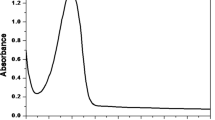Abstract.
Nanometer-sized L-cysteine-capped ZnS particles were synthesized by a colloidal aqueous method. The functionalized nanoparticles are water-soluble and suitable for biological applications. In Tris-HCl buffer solution, nucleic acids combine with cysteine-capped nano-ZnS particles by intermolecular forces to form larger nanoparticles. There are two resonance light scattering peaks at 304.5 nm and 373.8 nm, respectively. The enhanced RLS is related to the concentration of nucleic acids in the range of 0.04 to 1.2 µg mL−1 for calf thymus DNA and 0.2 to 1.0 µg mL−1 for fish sperm DNA. The detection limits (3δ) are 19 ng mL−1 for calf thymus DNA and 23 ng mL−1 for fish sperm DNA, respectively. Four synthetic samples were analyzed satisfactorily.
Similar content being viewed by others
Author information
Authors and Affiliations
Corresponding author
Rights and permissions
About this article
Cite this article
Li, Y., Chen, J., Zhuo, S. et al. Application of L-Cysteine-Capped ZnS Nanoparticles in the Determination of Nucleic Acids Using the Resonance Light Scattering Method. Microchim. Acta 146, 13–19 (2004). https://doi.org/10.1007/s00604-003-0168-0
Received:
Accepted:
Published:
Issue Date:
DOI: https://doi.org/10.1007/s00604-003-0168-0




